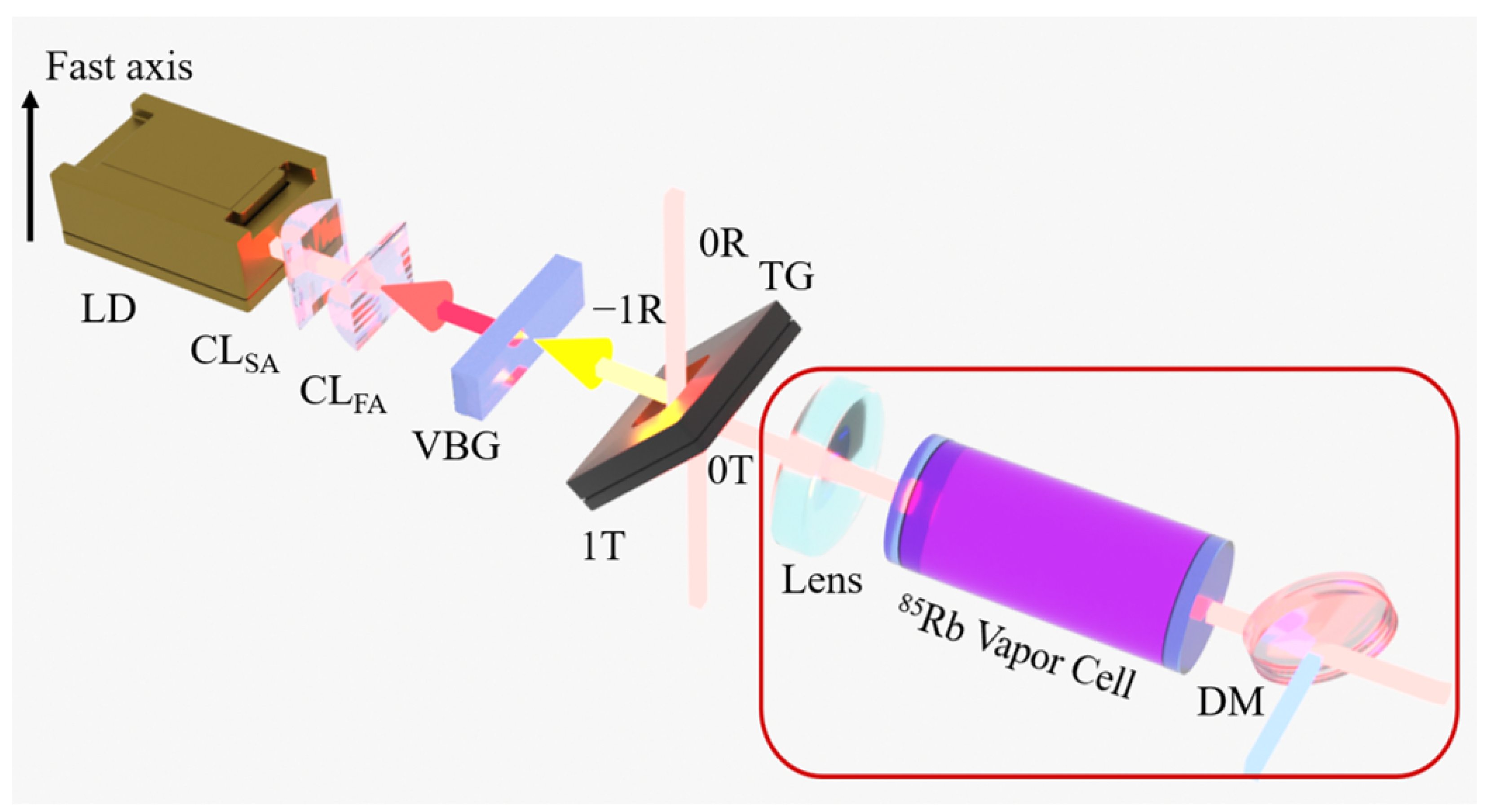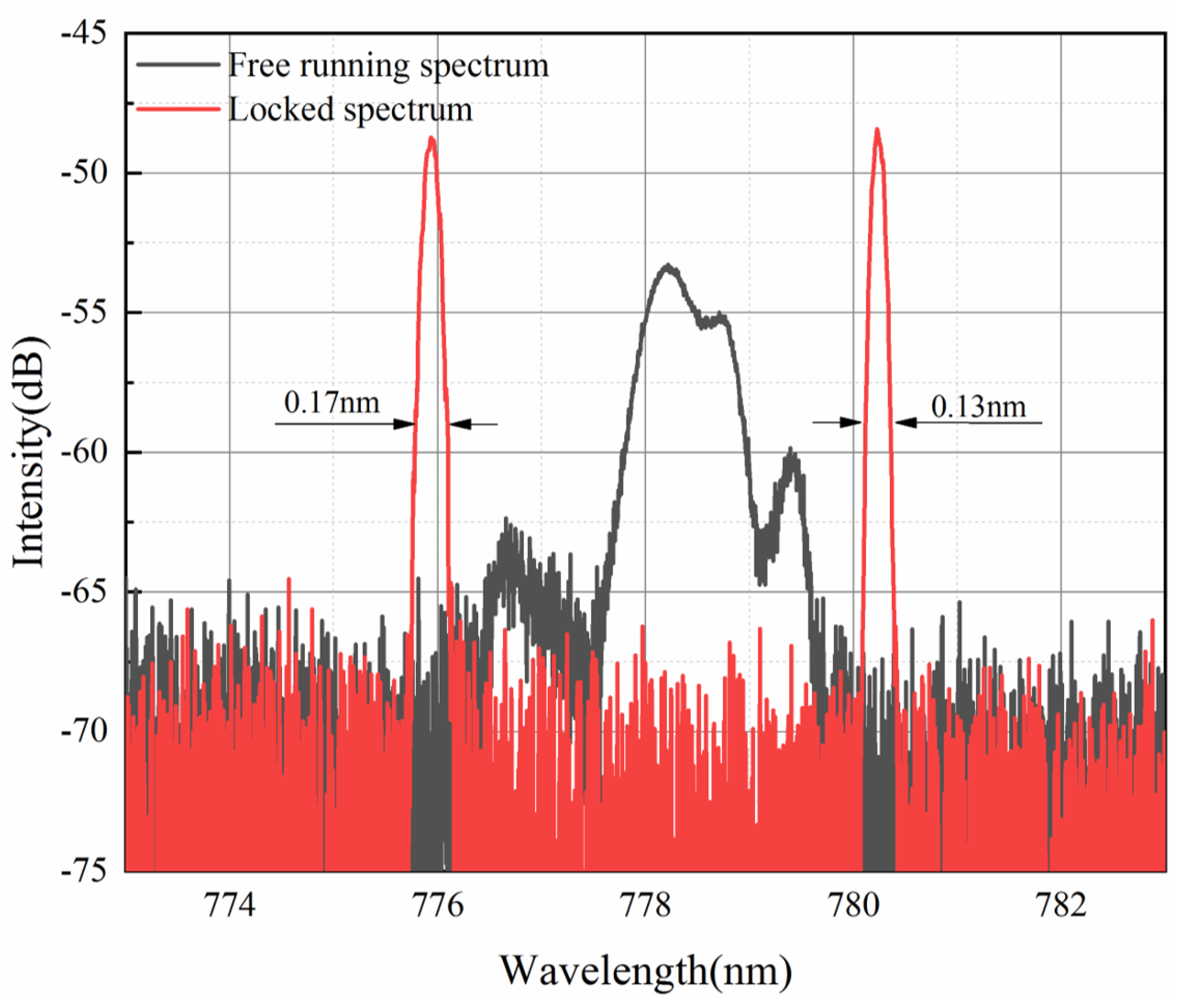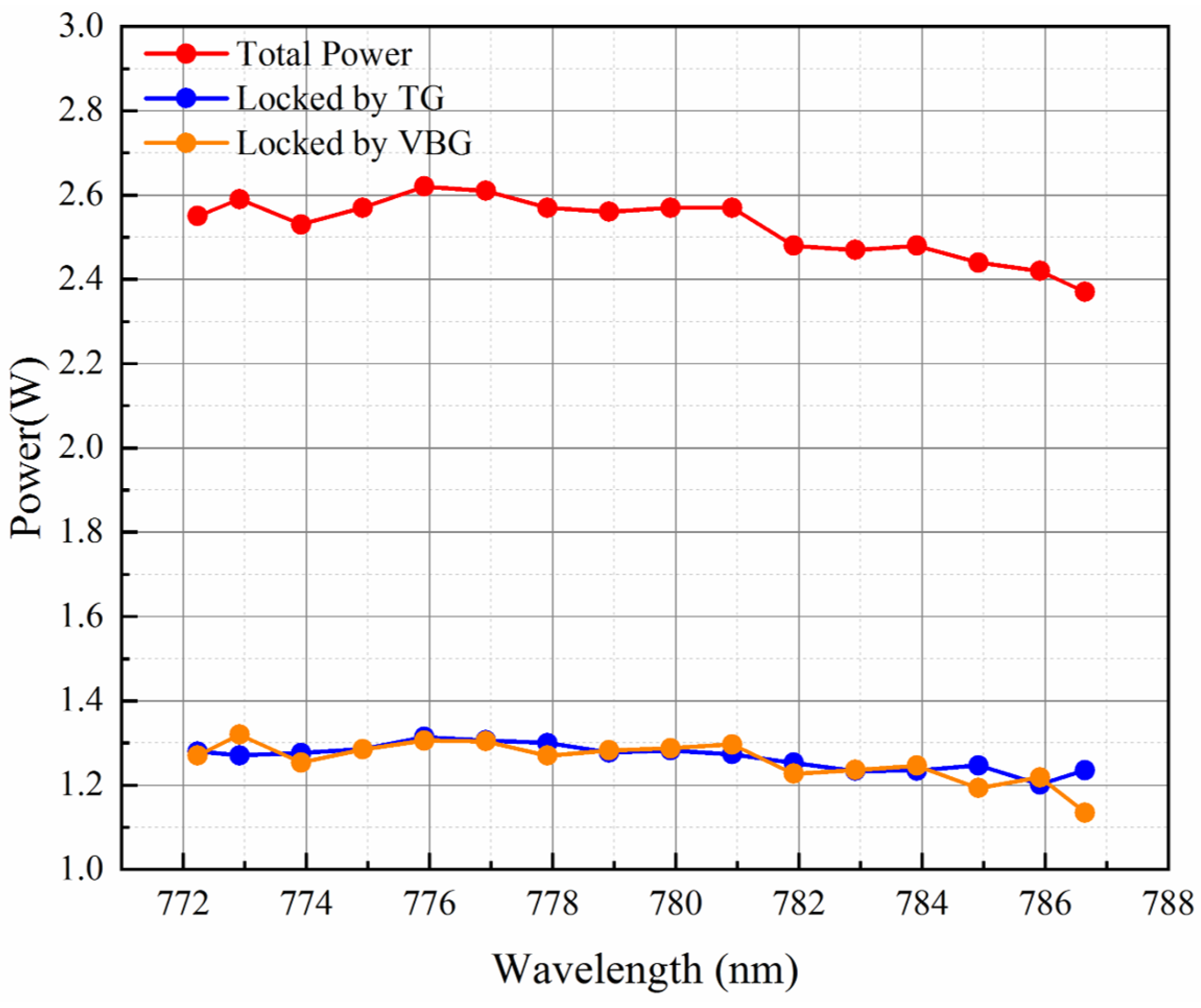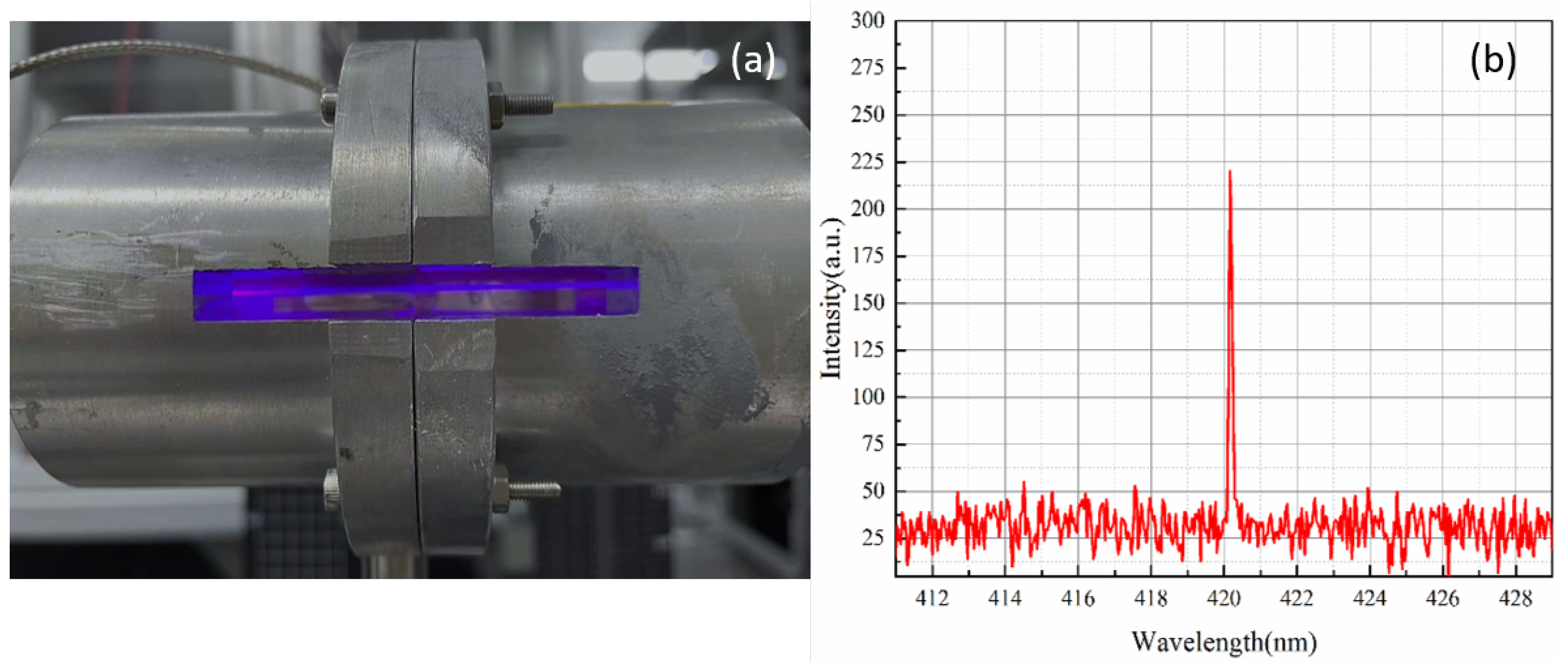Wide Tunable Spectrum and High Power Narrowed Linewidth Dual-Wavelength Broad Area Diode Laser
Abstract
1. Introduction
| Year | Reference | Wavelength Tuning Range | Power | Configuration | Key Feature |
|---|---|---|---|---|---|
| 2008 | Kim et al. [7] | 3 nm | Micro-Heater | Internal cavity | |
| 2016 | Sumpf et al. [8] | 2 nm | 0.2 W | Bragg reflector gratings | Internal cavity |
| 2009 | Zolotovskaya et al. [9] | 3 nm | 1.7 W | Multiplexed Bragg mirror | External cavity |
| 2011 | Chi et al. [10,11] | 6 nm | 1.5 W | Double Littrow gratings | External-cavity tapered amplifier |
| 2011 | Liu et al. [12] | 2 nm | 1.5 W | The reflective grating | Based on two diode laser arrays and a common external cavity |
| 2016 | Zheng et al. [13] | 23 nm | 0.04 W | The volume Bragg grating (VBG) and the reflective grating | Based on a double external cavity superluminescent diode (SLD) |
| 2018 | Zheng et al. [14] | 2 nm | 0.4 W | The volume Bragg grating (VBG) | External-cavity broad-area feedback (DFB) laser with a single external-cavity configuration |
| 2022 | Lu et al. [15] | 15 nm | >1.8 W | The VBG and the holographic reflective grating | Realization of dual-wavelength output power adjustment based on polarization |
2. Experiment
3. Results and Discussion
4. Application
5. Conclusions
Author Contributions
Funding
Informed Consent Statement
Data Availability Statement
Acknowledgments
Conflicts of Interest
References
- Jeon, M.Y.; Kim, N.; Shin, J.; Jeong, J.S.; Han, S.P.; Lee, C.W.; Leem, Y.A.; Yee, D.S.; Chun, H.S.; Park, K.H. Widely tunable dual-wavelength Er3+-doped fiber laser for tunable continuous-wave terahertz radiation. Opt. Express 2010, 18, 12291–12297. [Google Scholar] [CrossRef]
- Maiwald, M.; Eppich, B.; Ginolas, A.; Sumpf, B.; Erbert, G.; Tränkle, G. Compact Handheld Probe for Shifted Excitation Raman Difference Spectroscopy with Implemented Dual-Wavelength Diode Laser at 785 Na-nometers. Appl. Spectrosc. 2018, 69, 1144–1151. [Google Scholar] [CrossRef] [PubMed]
- Wang, S.Y.; Dai, K.; Han, J.H.; An, G.F.; Zhang, W.; Yu, Q.; Cai, H.; Nulahemaiti, N.; Liu, X.X.; Alghazi, A.; et al. Dual-wavelength end-pumped Rb-Cs vapor lasers. Appl. Opt. 2018, 57, 9563–9670. [Google Scholar] [CrossRef] [PubMed]
- Gu, P.; Tani, M.; Hyodo, M.; Sakai, K.; Hidaka, T. Generation of CW-Terahertz Radiation Using a Two Longitudinal-Mode Laser Diode. Jpn. J. Appl. Phys. 1998, 37, 976–978. [Google Scholar]
- Al-Mumin, M.; Kim, C.; Kim, I.; Jaafar, N.; Li, G. Injection locked multi-section gain-coupled dual mode DFB laser for terahertz generation. Opt. Commun. 2007, 275, 186–189. [Google Scholar] [CrossRef]
- Klehr, A.; Fricke, J.; Knauer, A.; Erbert, G.; Walther, M.; Wilk, R.; Mikulics, M.; Koch, M. High-Power Monolithic Two-Mode DFB Laser Diodes for the Generation of THz Radiation. IEEE J. Sel. Top. Quantum Electron. 2008, 14, 289–294. [Google Scholar] [CrossRef]
- Kim, N.; Shin, J.; Sim, E.; Lee, C.W.; Yee, D.; Jeon, M.; Jang, Y.; Park, K.H. Monolithic dual-mode distributed feedback semiconductor laser for tunable continuous-wave terahertz generation. Opt. Express 2009, 17, 13851–13859. [Google Scholar] [CrossRef]
- Sumpf, B.; Kabitzke, J.; Fricke, J.; Ressel, P.; Muller, A.; Maiwaid, M.; Tranke, G. Dual-wavelength diode laser with electrically adjustable wavelength distance at 785 nm. Opt. Lett. 2016, 41, 3694–3697. [Google Scholar] [CrossRef]
- Zolotovskaya, S.A.; Smirnov, V.I.; Venus, G.B.; Glebov, L.B.; Rafailov, E.U. Two-Color Output From In-GaAs Laser With Multiplexed Reflective Bragg Mirror. Opt. Lett. 2009, 21, 1093–1095. [Google Scholar]
- Chi, M.; Jensen, O.B.; Petersen, P.M. High-power dual-wavelength external-cavity diode laser based on ta-pered amplifier with tunable terahertz frequency difference. Opt. Lett. 2011, 36, 2626–2628. [Google Scholar] [CrossRef]
- Chi, M.; Jensen, O.B.; Petersen, P.M. Dual-wavelength high-power diode laser system based on an exter-nal-cavity tapered amplifier with tunable frequency difference. J. Opt. Soc. Am. B 2012, 29, 2617–2621. [Google Scholar] [CrossRef]
- Liu, B.; Braiman, Y. Spectral linewidth narrowing and tunable two-color laser operation of two diode laser arrays. Appl. Opt. 2012, 51, 1816–1821. [Google Scholar] [CrossRef]
- Zheng, Y.; Sekine, T.; Kurita, T.; Kato, Y.; Kawashima, T. Tunable continuous-wave dual wavelength laser by external-cavity superluminescent diode with a volume Bragg grating and a diffraction grating. Appl. Phys. Lett. 2016, 109, 141107. [Google Scholar] [CrossRef]
- Zheng, Y.; Sekine, T.; Kurita, T.; Kato, Y.; Kawashima, T. Continuous-wave dual-wavelength operation of a distributed feedback laser diode with an external cavity using a volume Bragg grating. Jpn. J. Appl. Phys. 2018, 57, 030307. [Google Scholar] [CrossRef]
- Lu, Y.; Zhang, W.; Fan, J.; Zhou, X.; Wang, Y.; Qu, H.; Zheng, W. High-power tunable dual-wavelength diode laser with a composite external cavity. Opt. Lett. 2022, 47, 2486–2489. [Google Scholar] [CrossRef] [PubMed]
- Zhao, H.; Jiang, L.; Li, L.; Li, M.; Wang, R.; Yang, Z.; Wang, H.; Yang, W.; Zhang, C.; Hua, W.; et al. Wide-spectrum Tuning and Narrowing of 780 nm Broad-Area Diode Laser with Littrow-Type Transmission Gratings. Photonics 2024, 11, 948. [Google Scholar] [CrossRef]
- Han, J.; Zhang, J.; Shan, X.; Peng, H.; Zhang, Y.; Qin, L.; Wang, L. Tunable ultra-narrow linewidth diode laser for multiple metastable rare gas pumping. Opt. Express 2023, 31, 13065–13072. [Google Scholar] [CrossRef]
- Akulshin, A.M.; Mclean, R.J.; Sidorov, A.I.; Hannaford, P. Coherent and collimated blue light generated by four-wave mixing in Rb vapour. Opt. Express 2009, 17, 22861–22870. [Google Scholar] [CrossRef]
- Schultz, J.T.; Abend, S.; Döring, D.; Debs, J.E.; Altin, P.A.; White, J.D.; Robins, N.P.; Close, J.D. Co-herent 455 nm beam production in a cesium vapor. Opt. Lett. 2009, 34, 2321. [Google Scholar] [CrossRef]
- Vernier, A.; Franke-Arnold, S.; Riis, E.; Arnold, A.S. Enhanced frequency up-conversion in Rb vapor. Opt. Express 2010, 18, 17020–17026. [Google Scholar] [CrossRef]
- Sell, J.F.; Gearba, M.A.; Depaola, B.D.; Knize, R.J. Collimated blue and infrared beams generated by two-photon excitation in Rb vapor. Opt. Lett. 2014, 39, 528–531. [Google Scholar] [CrossRef]
- Peng, Z.; Min, Y.A.; Pi, M.; Song, F.; Liang, L.; Wang, Y.; Zhang, Y.; Bai, X.; Zheng, C. On-chip near-infrared gas sensing based on slow light mode multiplexing in photonic crystal waveguides. Lab Chip, 2025; advance article. [Google Scholar] [CrossRef]
- Singhal, A. Slow-Light Enhanced Liquid and Gas Sensing Using 2-D Photonic Crystal Line Waveguides-A Review. IEEE Sens. J 2022, 22, 20126–20137. [Google Scholar] [CrossRef]
- Kim, I.; Lim, J.; Shim, J.; Park, J.; Ahn, S.; Lim, H.; Kim, S. Freestanding Germanium Photonic Crystal Waveguide for a Highly Sensitive and Compact Mid-Infrared On-Chip Gas Senor. ACS Sens. 2024, 22, 5116–5126. [Google Scholar] [CrossRef]





Disclaimer/Publisher’s Note: The statements, opinions and data contained in all publications are solely those of the individual author(s) and contributor(s) and not of MDPI and/or the editor(s). MDPI and/or the editor(s) disclaim responsibility for any injury to people or property resulting from any ideas, methods, instructions or products referred to in the content. |
© 2025 by the authors. Licensee MDPI, Basel, Switzerland. This article is an open access article distributed under the terms and conditions of the Creative Commons Attribution (CC BY) license (https://creativecommons.org/licenses/by/4.0/).
Share and Cite
Zhao, H.; Ye, Z.; Jiang, L.; Li, L.; Wang, R.; Yang, Z.; Yang, W.; Wang, H.; Hua, W.; Xu, X. Wide Tunable Spectrum and High Power Narrowed Linewidth Dual-Wavelength Broad Area Diode Laser. Photonics 2025, 12, 989. https://doi.org/10.3390/photonics12100989
Zhao H, Ye Z, Jiang L, Li L, Wang R, Yang Z, Yang W, Wang H, Hua W, Xu X. Wide Tunable Spectrum and High Power Narrowed Linewidth Dual-Wavelength Broad Area Diode Laser. Photonics. 2025; 12(10):989. https://doi.org/10.3390/photonics12100989
Chicago/Turabian StyleZhao, Huizi, Zi Ye, Longfei Jiang, Liang Li, Rui Wang, Zining Yang, Weiqiang Yang, Hongyan Wang, Weihong Hua, and Xiaojun Xu. 2025. "Wide Tunable Spectrum and High Power Narrowed Linewidth Dual-Wavelength Broad Area Diode Laser" Photonics 12, no. 10: 989. https://doi.org/10.3390/photonics12100989
APA StyleZhao, H., Ye, Z., Jiang, L., Li, L., Wang, R., Yang, Z., Yang, W., Wang, H., Hua, W., & Xu, X. (2025). Wide Tunable Spectrum and High Power Narrowed Linewidth Dual-Wavelength Broad Area Diode Laser. Photonics, 12(10), 989. https://doi.org/10.3390/photonics12100989





